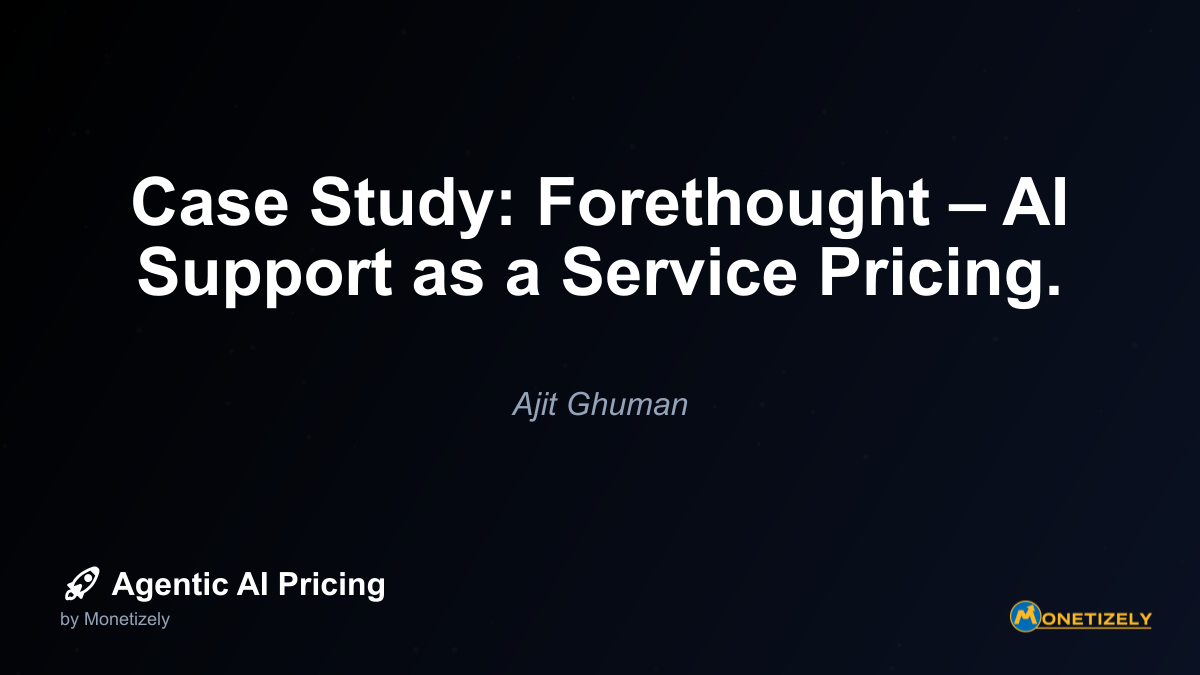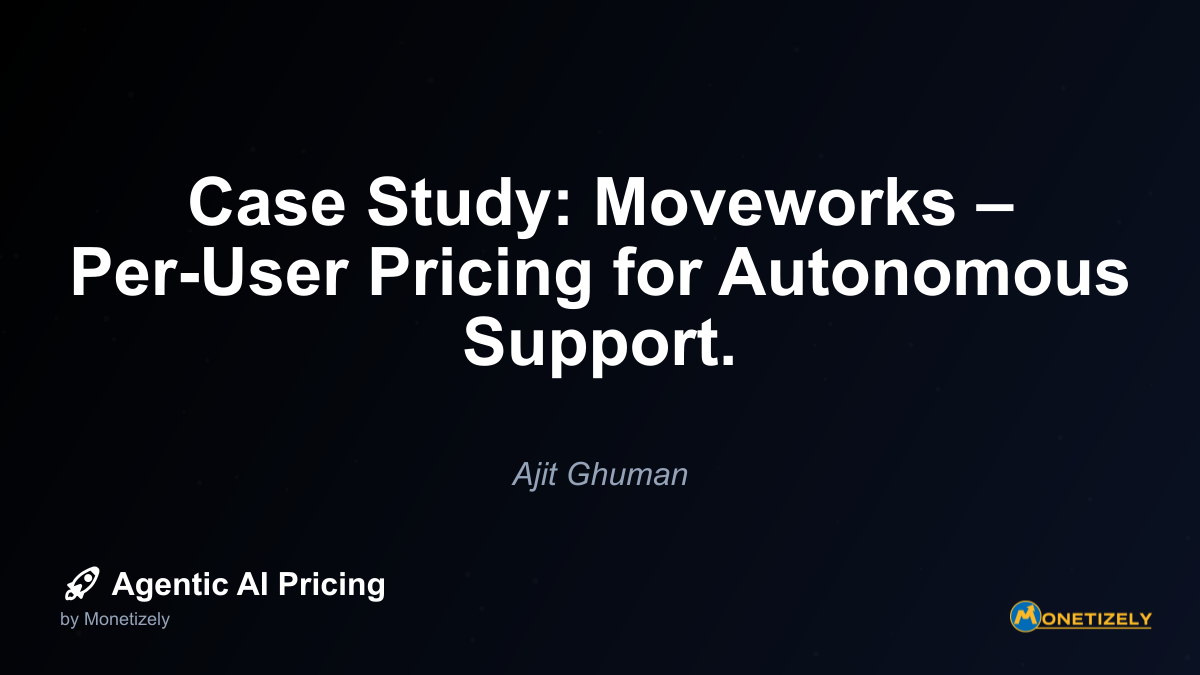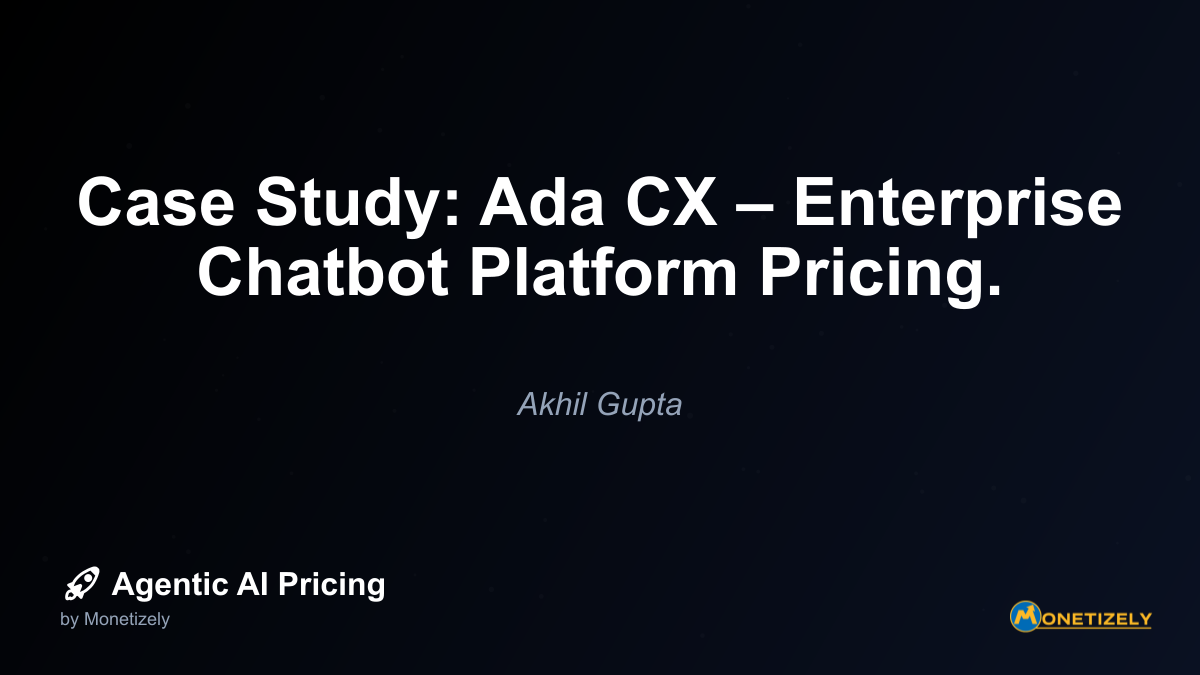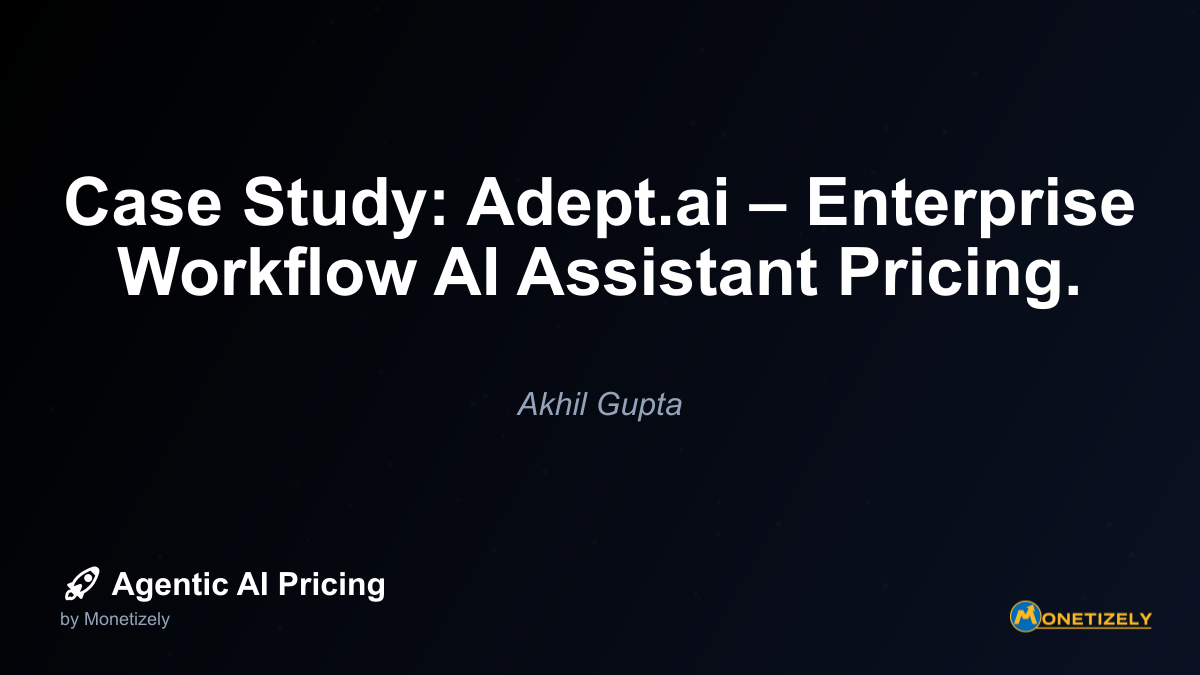· Ajit Ghuman · Case Studies · 11 min read
Case Study: Zendesk Resolution Bot – Outcome-Based Pricing Success.
AI and SaaS Pricing Masterclass
Learn the art of strategic pricing directly from industry experts. Our comprehensive course provides frameworks and methodologies for optimizing your pricing strategy in the evolving AI landscape. Earn a professional certification that can be imported directly to your LinkedIn profile.

Zendesk’s Resolution Bot represents a transformative approach to AI-powered customer service, standing out in the industry not only for its technological capabilities but for its revolutionary pricing model that aligns vendor success directly with customer outcomes. This case study examines how Zendesk’s outcome-based pricing strategy has created a win-win scenario that incentivizes continuous improvement in AI performance while delivering measurable business value to customers.
The Evolution of Support Automation: Beyond Chatbots
Customer service automation has evolved dramatically since the early days of rule-based chatbots. Traditional support automation tools were typically priced based on volume metrics—number of users, conversations, or messages processed—regardless of whether they actually solved customer problems. This created a fundamental misalignment: vendors could profit from high usage volumes even when their solutions failed to resolve customer issues.
Zendesk recognized this misalignment and took a bold step with its Resolution Bot by introducing a radically different approach: charging customers only when the AI successfully resolves customer issues without human intervention.
As Zendesk CEO Tom Eggemeier emphasized, “Our network of AI agents… ensuring every interaction leads to a resolution. And as the only large service software provider offering outcome-based pricing, we make sure customers only pay for problems that are resolved – not for interactions or failed attempts.”
Understanding Zendesk’s Resolution Bot Technology
At its core, Zendesk’s Resolution Bot leverages sophisticated machine learning and natural language processing technologies to understand customer queries and provide relevant solutions. The system works through several key mechanisms:
Advanced NLP and Intent Recognition: The bot processes customer queries in real-time using natural language processing to interpret intent and context.
Knowledge Base Integration: It searches connected knowledge bases to find closely matching articles and information.
Continuous Learning: The system improves over time through ongoing training and optimization, learning from successful and unsuccessful interactions.
Multi-channel Deployment: The bot can be deployed across various customer touchpoints, including chat windows, mobile apps, and platforms like Slack.
Seamless Human Handoff: When the bot cannot resolve an issue, it smoothly transfers the conversation to a human agent with full context.
What sets the Resolution Bot apart technically is its integration with Zendesk’s comprehensive Resolution Platform, which leverages advanced AI reasoning capabilities and a knowledge graph aggregating tens of thousands of active service knowledge bases. This ensures relevant context and content delivery, significantly enhancing resolution rates compared to traditional chatbots.
The Outcome-Based Pricing Innovation
Zendesk’s most significant innovation with the Resolution Bot is its pricing model, which directly ties costs to successful outcomes rather than usage metrics. This approach fundamentally realigns incentives between Zendesk and its customers.
How the Pricing Model Works
Under this model:
Pay Only for Resolutions: Customers are charged only when the AI bot successfully resolves a customer issue without human intervention.
No Charge for Escalations: If the bot cannot resolve an issue and transfers it to a human agent, the customer is not charged for that interaction.
Clear Definition of “Resolution”: Zendesk implements a rigorous validation process to determine when an issue is truly resolved, including a 72-hour resolution window to avoid billing for abandoned or repeat issues within that period.
Tiered Pricing Structure: The cost starts at approximately $1.50 per resolution for committed usage volumes, or $2 per resolution on a pay-as-you-go basis.
Flexible Volume Commitments: Customers can purchase additional resolution packs if they exceed their plan allocation.
This pricing innovation was officially announced in August 2024, with the full transition for existing bot usage commitments set for November 2024. New or renewing customers have had the model in effect since December 2024 onwards.
Measuring Success: Validation and Metrics
A critical aspect of outcome-based pricing is defining and measuring what constitutes a “resolution.” Zendesk has implemented robust mechanisms to ensure accurate billing and build trust with customers:
Resolution Validation: Zendesk uses a combination of rule-based checks and AI assessment to confirm that a problem is genuinely solved before billing.
Monitoring Dashboards: Customers have access to real-time dashboards to track AI agent activity and costs.
Transparent Metrics: Clear definitions and measurement of what qualifies as a resolved interaction are built into the pricing model.
Contractual Clarity: Updated contract terms clearly outline success criteria and validation methods.
This transparency is essential for building trust in an outcome-based pricing model, where the definition of “success” could potentially be manipulated. By providing customers with visibility into the resolution process and clear metrics, Zendesk addresses a common concern with outcome-based pricing: the “black box” problem where customers may distrust vendor-controlled success criteria.
Customer Impact: Real-World Results
The outcome-based pricing model has delivered significant benefits for Zendesk’s customers across various industries:
Case Study: Crosscard/Viabuy
This fintech company implemented Zendesk’s Answer Bot (a version of the Resolution Bot) and saw remarkable results:
- 10,095 questions resolved in the first year
- Over 5,000 additional tickets prevented from reaching human agents
- Support teams met their first response time goals 90-95% of the time
Case Study: ShopBack
This rewards and discovery platform in Asia-Pacific achieved:
- 70% of all incoming tickets resolved through automation
- Significant improvement in agent capacity to handle complex issues
- Enhanced customer satisfaction through faster resolution times
Broader Performance Metrics
Across its customer base, Zendesk has reported impressive performance metrics:
- Baseline resolution rates typically range from 6-10% of tickets resolved without human agents
- With optimization over 6+ months, resolution rates can improve to 8-12%
- Suggestion accuracy averages between 70-80%
- Typical deflection rates (customer issues fully resolved or avoiding escalation) around 15-20%
- Customer satisfaction scores for bot interactions above 80%
These metrics demonstrate that the outcome-based pricing model is not just a theoretical innovation but delivers tangible business value by incentivizing Zendesk to continuously improve its AI’s resolution capabilities.
Financial Impact for Zendesk
The outcome-based pricing model has had a significant positive impact on Zendesk’s business:
Revenue Growth: According to a Forrester Total Economic Impact study, Zendesk’s AI capabilities—including the Resolution Bot—help organizations automate customer inquiry resolutions, leading to incremental additional sales growing from $3.75 million in year one to $18.15 million in year three.
Customer Acquisition and Retention: The Resolution Bot’s ability to automate up to 70% of incoming tickets has boosted customer satisfaction and loyalty, reducing churn.
Market and Investor Response: The innovative pricing model has been well-received by the market, with positive responses at Zendesk’s 2025 Relate conference, which attracted over 2,000 participants.
Revenue Predictability: The outcome-based model has the potential to improve Zendesk’s revenue predictability by tying pricing to realized value rather than volume metrics.
This financial success demonstrates that aligning pricing with customer outcomes can be a winning strategy not just for customers but for vendors as well.
The Strategic Rationale: Why Outcome-Based Pricing?
Zendesk’s shift to outcome-based pricing reflects a deeper strategic understanding of how AI is transforming customer service and software pricing more broadly.
Alignment with Value Delivery
Traditional pricing models for AI solutions often fail to capture the true value delivered. By charging only for successful resolutions, Zendesk creates perfect alignment between what customers pay and the value they receive. This addresses a common concern with AI investments: proving ROI.
Risk Sharing
The outcome-based model fundamentally shifts risk from the customer to the vendor. If the AI doesn’t perform as expected, the customer doesn’t pay. This makes the decision to adopt AI-powered solutions less risky for customers, potentially accelerating adoption.
Focus on Continuous Improvement
Perhaps most importantly, outcome-based pricing creates a powerful incentive for Zendesk to continuously improve its AI capabilities. Since revenue is directly tied to successful resolutions, every improvement in the AI’s performance directly impacts the bottom line. This creates a virtuous cycle of investment in AI capabilities, better performance, more satisfied customers, and increased revenue.
As Adrian McDermott, Zendesk CTO, emphasized: “The only outcome that matters is resolution, and until now, bots have been somewhat limited in their ability to achieve it.” This focus on true resolution rather than superficial engagement metrics represents a fundamental shift in how customer service automation is evaluated and priced.
Challenges and Limitations
Despite its success, Zendesk’s outcome-based pricing model is not without challenges:
Definition Complexity
Defining what constitutes a “resolution” is inherently complex, especially for nuanced or multi-part customer issues. This complexity can lead to disputes or misunderstandings about billing.
Performance Variability
AI performance can vary based on factors outside Zendesk’s control, such as the quality of a customer’s knowledge base or the complexity of their product offerings. This can create uneven experiences across different customers.
Integration Requirements
Maximizing resolution rates often requires significant integration work and knowledge base optimization, which may create implementation barriers for some customers.
AI Limitations
While continuously improving, the Resolution Bot still has limitations when handling complex, nuanced queries. Some customers report that while AI bots improve resolution rates (75-85% in some cases), they are not full replacements for human agents in complex scenarios.
These challenges highlight the importance of transparency, clear metrics, and ongoing collaboration between Zendesk and its customers to ensure the outcome-based pricing model works effectively for all parties.
Broader Industry Implications
Zendesk’s outcome-based pricing innovation has significant implications for the broader AI and enterprise software industry:
Shifting Vendor Priorities
When vendors are paid based on outcomes rather than usage, their priorities shift from driving adoption and engagement to ensuring measurable business results. This creates stronger alignment with customer goals and may accelerate the development of more effective AI solutions.
Customer Expectations
As more customers experience outcome-based pricing, expectations are likely to shift across the industry. Customers may increasingly demand pricing tied to measurable ROI rather than traditional subscription or usage-based models.
Industry Standards
Zendesk’s move could catalyze the development of industry standards for measuring and validating AI outcomes, creating more transparency and consistency across vendors.
Future Pricing Evolution
As AI capabilities mature, outcome-based pricing models are likely to become more sophisticated, potentially incorporating multiple outcome metrics or hybrid approaches that combine outcome-based components with more traditional pricing elements.
Implementation Considerations for Enterprises
For organizations considering Zendesk’s Resolution Bot or similar outcome-based AI solutions, several implementation considerations are crucial:
Knowledge Base Quality
The effectiveness of the Resolution Bot depends heavily on the quality, comprehensiveness, and organization of the knowledge base it accesses. Investing in knowledge base optimization is essential for maximizing resolution rates.
Clear Success Metrics
Before implementing an outcome-based solution, organizations should clearly define what constitutes success, how it will be measured, and how disputes will be resolved.
Integration Strategy
The Resolution Bot works best when fully integrated into the customer service ecosystem, with seamless handoffs between automated and human support. A comprehensive integration strategy is essential.
Change Management
Moving to an outcome-based model requires significant change management, including adjusting expectations, processes, and potentially team structures to maximize the value of AI automation.
Ongoing Optimization
Achieving the highest resolution rates requires continuous optimization based on performance data and customer feedback. Organizations should plan for this ongoing effort rather than treating implementation as a one-time project.
Future Outlook: Where Does Outcome-Based Pricing Go From Here?
Looking ahead, Zendesk’s outcome-based pricing innovation is likely just the beginning of a broader transformation in how AI solutions are priced and evaluated:
More Sophisticated Outcome Metrics
Future models may incorporate multiple outcome metrics beyond simple resolution rates, potentially including customer satisfaction scores, resolution speed, or even business impact metrics like customer retention or lifetime value.
Hybrid Models
We may see the emergence of hybrid pricing models that combine outcome-based components with more traditional elements, providing flexibility while maintaining alignment with customer goals.
Ecosystem-Wide Metrics
As AI becomes more integrated across customer service ecosystems, pricing models may evolve to measure collective outcomes across multiple tools and platforms rather than focusing on single-product results.
Predictive Pricing
AI-enhanced predictive analytics may enable more sophisticated pricing models that set realistic, agreed-upon targets pre-deployment and identify success factors dynamically.
Regulatory Considerations
As outcome-based pricing becomes more common, regulatory scrutiny may increase, potentially leading to standards for disclosure, dispute resolution, and fairness in outcome measurement.
Conclusion: A New Paradigm for AI Value
Zendesk’s Resolution Bot with its outcome-based pricing represents more than just an innovative product or pricing strategy—it signals a fundamental shift in how AI value is delivered, measured, and monetized.
By aligning pricing directly with successful outcomes, Zendesk has created a model that benefits all stakeholders: customers pay only for value received, Zendesk is incentivized to continuously improve its AI capabilities, and end users experience better, faster resolution of their issues.
This approach addresses one of the most significant challenges in AI adoption: proving and capturing the value created. By making this value explicit and directly tying it to pricing, Zendesk has created a transparent model that builds trust and accelerates adoption.
As AI continues to transform customer service and other enterprise functions, outcome-based pricing models like Zendesk’s are likely to become increasingly common, reshaping expectations and standards across the industry. Organizations that embrace this shift—both as vendors and as customers—will be better positioned to capture the full value of AI while building stronger, more aligned partnerships.
The ultimate lesson from Zendesk’s success is clear: when it comes to AI pricing, focusing on outcomes rather than inputs or activities creates the strongest foundation for sustainable value creation and business success.
Co-Founder & CEO
Ajit is the author of Price To Scale, a top book on SaaS Pricing and is the Founder of Monetizely. Ajit has led and worked in pricing and product marketing at firms like Twilio, Narvar and Medallia. His work has been featured in Forbes and VentureBeat. Ajit regularly consults with software companies from Seed stage to post-IPO on pricing strategy. Ajit is also a highly-rated co-instructor for 'The Art of SaaS Pricing and Monetization' on Maven.
Pricing Strategy Audit
Let our experts analyze your current pricing strategy and identify opportunities for improvement. Our data-driven assessment will help you unlock untapped revenue potential and optimize your AI pricing approach.




